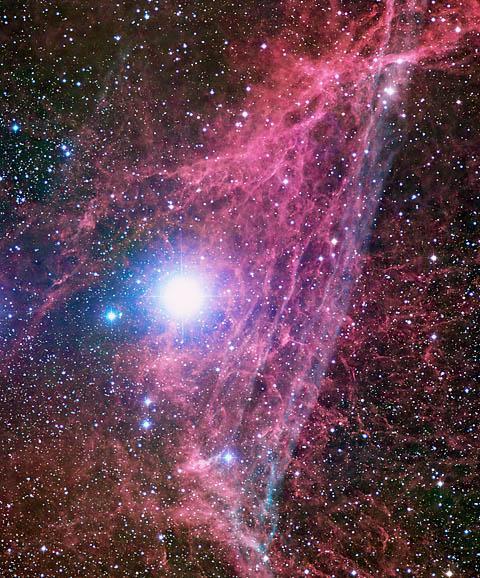
Part of the Vela supernova remnant
A supernova event marks the catastrophic end-point in the life of a massive star. The self-destruction of the star releases a huge amount of energy as radiation of all kinds, but a substantial fraction of the force of the explosion blasts the outer part of the supernova into an expanding shell of matter that travels through the almost empty space between the stars. As the rapidly moving blast wave encounters the relatively stationary interstellar medium it creates a very narrow, luminous shock front that appears as a faint nebula. Because the shock front is very convoluted the nebulosity appears to be highly structured and the various colours define different energy levels within the interaction.
Though the star responsible for the Vela supernova remnant exploded 12,000 years ago, it is still affecting its environment. The other supernova remnant associated with the explosion is a neutron star, a pulsar, PSR J0835-4510, rotating 11 times a second. It it not in this image, and in any case would be too faint to be seen here.
Credit: Australian Astronomical Observatory, photograph by David Malin.
A supernova event marks the catastrophic end-point in the life of a massive star. The self-destruction of the star releases a huge amount of energy as radiation of all kinds, but a substantial fraction of the force of the explosion blasts the outer part of the supernova into an expanding shell of matter that travels through the almost empty space between the stars. As the rapidly moving blast wave encounters the relatively stationary interstellar medium it creates a very narrow, luminous shock front that appears as a faint nebula. Because the shock front is very convoluted the nebulosity appears to be highly structured and the various colours define different energy levels within the interaction.
Though the star responsible for the Vela supernova remnant exploded 12,000 years ago, it is still affecting its environment. The other supernova remnant associated with the explosion is a neutron star, a pulsar, PSR J0835-4510, rotating 11 times a second. It it not in this image, and in any case would be too faint to be seen here.
Credit: Australian Astronomical Observatory, photograph by David Malin.
Call me when you've found a cab to that place! :D
ReplyDelete